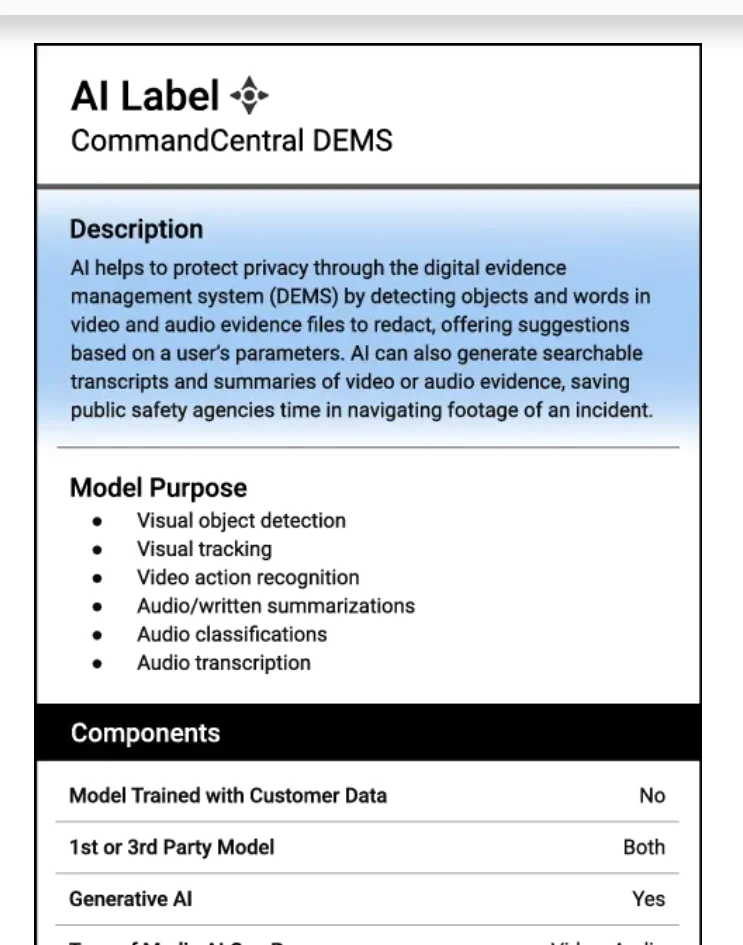Trust Center: AI Labels

AI labels: Describing AI’s use in safety and security technologies
Motorola Solutions AI-enabled technologies help to augment human focus, effort and performance when seconds matter. AI labels provide clear, concise descriptions of how AI is used in their products.
How Motorola Solutions designs AI-assisted experiences
AI must be responsibly designed for mission-critical contexts in order to reliably assist people - and supercharge human capability - in critical moments of safety or security.
At its core, we design AI to maximize human strengths like judgment and reasoning, and to adapt to changing roles, tasks, risk levels and cognitive states. Motorola Solutions AI design principles include:
Make it accountable
Motorola Solutions believes AI outputs should be traceable and transparent, whereby the user can easily see, check and override AI’s recommendations.
Make it contextual
Motorola Solutions believes AI should provide information tailored to the user’s role, task and current situation for optimized assistance.
Make it engaging
Motorola Solutions believes AI design should keep users cognitively engaged and alert to avoid blind trust or overreliance in technology.
Make it tangible
Motorola Solutions believes a user should be able to understand how AI conclusions were reached and see the sources from which suggestions were drawn.
How to read an AI label
AI labels explain the type of AI used in a product, who owns the data processed, human controls and the purpose behind the product’s specific application of AI.
Explore how to read each section of an AI label below.

Description
Offers a clear, concise summary of how AI is used in the product. AI is a technology that enables computers and machines to simulate human intelligence and problem solving. AI is an overarching term that includes machine learning and generative AI.
Model purpose
Explains why the AI model(s) is used in the product. Examples include:
- Anomaly detection, or determining whether identified data is unusual or atypical against established patterns.
- Audio transcription, or converting spoken words from an audio file into written text.
Model trained with customer data
Denotes whether AI models in the product were trained with customer data. This is application dependent.
1st or 3rd party model
Explains the AI model source. A first party - or proprietary AI model - is developed in-house whereas a third party model is developed outside Motorola Solutions and made available by a third party vendor. In some instances Motorola Solutions may customize third party models.
Generative AI
Denotes whether the product leverages an AI model that can generate images, videos, audio, text or other processed content. This type of AI model is also known as “GenAI.”
Type of media AI can process
Details what formats of media the AI model(s) can process, for example, video, audio or text.
Customer data AI can access
Explains who controls the data processed by the AI model(s) and who sets data retention policies.
AI definitions and terminology
Clarity in AI terminology is foundational to describing its use in safety and security technologies.
AI model
An AI model is a term used to describe the type of AI being used in a product. There may be more than one model used in a product. AI models can be either machine learning or generative AI.
Machine learning
Machine learning is the use and development of computer systems that are able to learn and adapt without following explicit instructions by using algorithms and statistical models to analyze and draw inferences from patterns in data.
Generative AI vs. AI
Generative AI, or GenAI, is a type of AI model that can generate images, videos, audio, text or other processed content.
Agentic AI
Agentic AI is an AI system that can accomplish a specific goal with limited supervision.
AI agent
AI agents are AI systems that can mimic human decision making to learn, adapt and solve problems in real time.
Edge AI
Edge AI is the capability for AI models and tools to operate directly on a user's device without an active internet connection. Unlike cloud-based AI, which relies on remote servers, edge AI allows users to perform tasks such as natural language processing, image recognition and machine learning even in areas with limited or no internet connectivity.
Explore Motorola Solutions products’ AI labels
Want to read more AI labels? Visit MSI’s AI labels by clicking on the links below.

